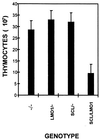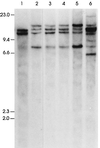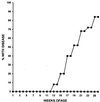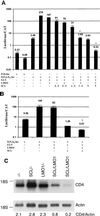Disordered T-cell development and T-cell malignancies in SCL LMO1 double-transgenic mice: parallels with E2A-deficient mice
- PMID: 10373552
- PMCID: PMC84335
- DOI: 10.1128/MCB.19.7.5025
Disordered T-cell development and T-cell malignancies in SCL LMO1 double-transgenic mice: parallels with E2A-deficient mice
Abstract
The gene most commonly activated by chromosomal rearrangements in patients with T-cell acute lymphoblastic leukemia (T-ALL) is SCL/tal. In collaboration with LMO1 or LMO2, the thymic expression of SCL/tal leads to T-ALL at a young age with a high degree of penetrance in transgenic mice. We now show that SCL LMO1 double-transgenic mice display thymocyte developmental abnormalities in terms of proliferation, apoptosis, clonality, and immunophenotype prior to the onset of a frank malignancy. At 4 weeks of age, thymocytes from SCL LMO1 mice show 70% fewer total thymocytes, with increased rates of both proliferation and apoptosis, than control thymocytes. At this age, a clonal population of thymocytes begins to populate the thymus, as evidenced by oligoclonal T-cell-receptor gene rearrangements. Also, there is a dramatic increase in immature CD44(+) CD25(-) cells, a decrease in the more mature CD4(+) CD8(+) cells, and development of an abnormal CD44(+) CD8(+) population. An identical pattern of premalignant changes is seen with either a full-length SCL protein or an amino-terminal truncated protein which lacks the SCL transactivation domain, demonstrating that the amino-terminal portion of SCL is not important for leukemogenesis. Lastly, we show that the T-ALL which develop in the SCL LMO1 mice are strikingly similar to those which develop in E2A null mice, supporting the hypothesis that SCL exerts its oncogenic action through a functional inactivation of E proteins.
Figures











Similar articles
-
scid Thymocytes with TCRbeta gene rearrangements are targets for the oncogenic effect of SCL and LMO1 transgenes.Cancer Res. 2001 Sep 1;61(17):6382-7. Cancer Res. 2001. PMID: 11522630
-
SCL and LMO1 alter thymocyte differentiation: inhibition of E2A-HEB function and pre-T alpha chain expression.Nat Immunol. 2000 Aug;1(2):138-44. doi: 10.1038/77819. Nat Immunol. 2000. PMID: 11248806
-
An scl gene product lacking the transactivation domain induces bony abnormalities and cooperates with LMO1 to generate T-cell malignancies in transgenic mice.EMBO J. 1997 May 1;16(9):2408-19. doi: 10.1093/emboj/16.9.2408. EMBO J. 1997. PMID: 9171354 Free PMC article.
-
Intertwining proteins in thymocyte development and cancer.Nat Immunol. 2000 Aug;1(2):97-8. doi: 10.1038/77881. Nat Immunol. 2000. PMID: 11248796 Review. No abstract available.
-
Transcription factors of the bHLH and LIM families: synergistic mediators of T cell acute leukemia?Curr Top Microbiol Immunol. 1997;220:55-65. doi: 10.1007/978-3-642-60479-9_4. Curr Top Microbiol Immunol. 1997. PMID: 9103675 Review. No abstract available.
Cited by
-
Polycomb group proteins: navigators of lineage pathways led astray in cancer.Nat Rev Cancer. 2009 Nov;9(11):773-84. doi: 10.1038/nrc2736. Nat Rev Cancer. 2009. PMID: 19851313 Review.
-
[Study on expression of LIM domain only protein 1 in SD rat oral buccal mucosa carcinogenesis induced by 4-nitro-quinoline N-oxide].Hua Xi Kou Qiang Yi Xue Za Zhi. 2020 Apr 1;38(2):133-138. doi: 10.7518/hxkq.2020.02.004. Hua Xi Kou Qiang Yi Xue Za Zhi. 2020. PMID: 32314884 Free PMC article. Chinese.
-
High-throughput screening in niche-based assay identifies compounds to target preleukemic stem cells.J Clin Invest. 2016 Dec 1;126(12):4569-4584. doi: 10.1172/JCI86489. Epub 2016 Oct 31. J Clin Invest. 2016. PMID: 27797342 Free PMC article.
-
OLIG2 (BHLHB1), a bHLH transcription factor, contributes to leukemogenesis in concert with LMO1.Cancer Res. 2005 Aug 15;65(16):7151-8. doi: 10.1158/0008-5472.CAN-05-1400. Cancer Res. 2005. PMID: 16103065 Free PMC article.
-
NUP98-HOXD13 transgenic mice develop a highly penetrant, severe myelodysplastic syndrome that progresses to acute leukemia.Blood. 2005 Jul 1;106(1):287-95. doi: 10.1182/blood-2004-12-4794. Epub 2005 Mar 8. Blood. 2005. PMID: 15755899 Free PMC article.
References
-
- Aplan P D, Lombardi D P, Ginsberg A M, Cossman J, Bertness V I, Kirsch I R. Disruption of the human SCL locus by “illegitimate” V-(D)-J recombinase activity. Science. 1990;250:1426–1429. - PubMed
Publication types
MeSH terms
Substances
Grants and funding
LinkOut - more resources
Full Text Sources
Other Literature Sources
Molecular Biology Databases
Research Materials
Miscellaneous
